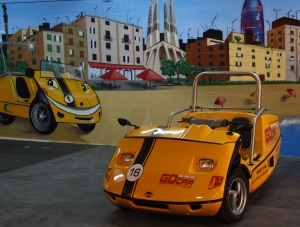If you wish to contribute or participate in the discussions about articles you are invited to contact the Editor
Tourist Information
| Applications | |
|---|---|
| Title | Tourist Information |
| Author(s) | Rui Barradas Pereira. |
| Level | Basic |
| Year of Publication | 2011 |
Tourist Information applications provide guidance and landmark information to tourists typically in urban environments.
Some tourist information services could be fitted in the Location based Information Streams. But since tourist applications can have been one the most dynamic areas of LBS and increasingly sophisticated applications are being deployed, it makes sense for tourism applications to be a separate category.
Tourism Information applications can range from providing the user with the nearest restaurant or landmark to being a full blown city guide with multimedia information and guided audio tours.
Application Architecture
Tourist Information Services depend normally on an architecture that includes a multimedia user mobile device and a multimedia database of tourist information for a city or a region. In tourist information applications the information is usually stored locally since the multimedia content is far more demanding in terms of bandwidth and normally the user cellular connection is in roaming.
The user mobile device is usually a PDA, smartphone or even a tablet computer with internet access, localization capabilities and a multimedia user interface that can display high-resolution graphics.
The functionalities usually provided by these applications are[1]:
- The user can browse information about the site and about the surrounding landmarks. The information can be provided as text, audio or images.
- The user can follow guided tours stored in the database. This functionality is a mix of pedestrian navigation and tourist guide where the user is guided through the streets and in the proximity of a landmark the application provides information about it in text, audio, image or video format.
- Functionality similar to the nearest business or service discussed in the article on Location based Information Streams is normally provided.
- Pedestrian navigation can be provided to assist the user to go from one site to the other.
- Some of these applications are free, being financed by local authorities and sponsors. Advertising can be supported and will be delivered to the user when in certain locations or in certain stages of the guided-tours.
- In some cases weather and local transportation information is also provided by the application.
- Online servers can be used instead of local databases.
These applications are considered non-critical applications.
The precision required by these applications is low, being the current accuracy provided by civilian GPS enough.
GNSS guided tours
The most interesting aspect of the Tourist Information Applications is the guided tour functionality. The functionality can provide an enhanced touristic experience to the users by both guiding the user to most important and relevant sites and landmarks. At the same time context information about the sites is provided to the users. If audio is used, additional information can be provided while the user goes from one landmark to the other instead having to stop to read the information on a paper guide.
Some of these guides are even free to the user since they are produced by local authorities, eventually with the support of sponsors in exchange for advertising. Some of them use freely available information such as Wikipedia content as basis for landmark description.
In some cities tour operators took the concept one step ahead by renting buggies and segways that have a guided tour application integrated in the vehicle. The guided tour application navigates the users through the tour and provides landmark information during them[2][3].
Application Examples
Applications and services that fit in this category are:
- Audioguidia[4]: Audioguides for your iPhone/iPod/iPad
- toozla[5]: City and travel audio guides for your Bada (Samsung), Android, iPhone/iPod/iPad and J2ME
- Digi-Guide[6]: The Digi-Guide is based on a GNSS-enabled mobile device that allows being guided and being given information on main Points of Interest of a city.
- GoCar Tours[2]: GNSS Guided Tours in two-seated buggies.
- Red Tour[3]: Lisbon GNSS Guided Tours in electric vehicles (two and four-seated buggies, segways and electric bikes).
Notes

